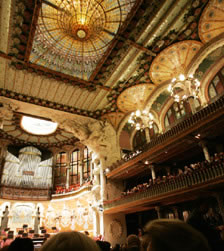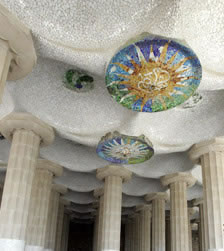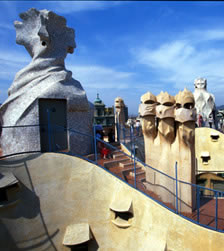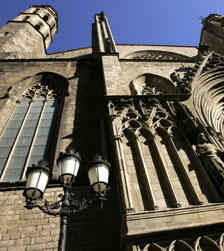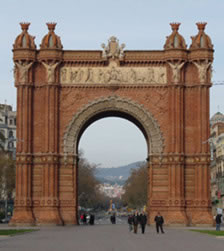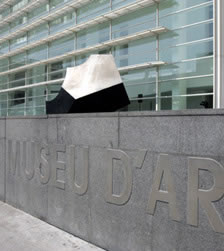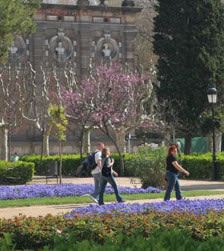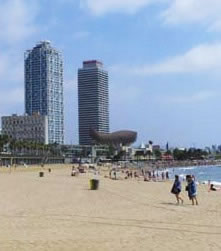http://www.bcn.cat/en/
http://en.wikipedia.org/wiki/Barcelona
Barcelona is the second largest city in Spain after Madrid, and the capital of Catalonia, with a population of 1,621,537 within its administrative limits on a land area of 101.4 km2. The urban area of Barcelona extends beyond the administrative city limits with a population of between 4,200,000 and 4,500,000 on an area of 803 km2 being the sixth-most populous urban area in the European Union after Paris, London, Ruhr area, Madrid and Milan. It is also Europe's largest metropolis on the Mediterranean coast.
Barcelona is today one of the world's leading tourist, economic, trade fair/exhibitions and cultural-sports centers, and its influence in commerce, education, entertainment, media, fashion, science, and the arts all contribute to its status as one of the world's major global cities. Indeed, it is a major economic centre and a growing financial centre (Diagonal Mar area and Gran Via). One of Europe's principal Mediterranean ports can be found here as well as Barcelona international airport, which handles about 30 million passengers per year. It also boasts an extensive motorway network and is a hub of high-speed rail, particularly that which will link France with Spain. Barcelona is the 16th-most-visited city in the world and the fourth most visited in Europe after Paris, London, and Rome, with several million tourists every year.
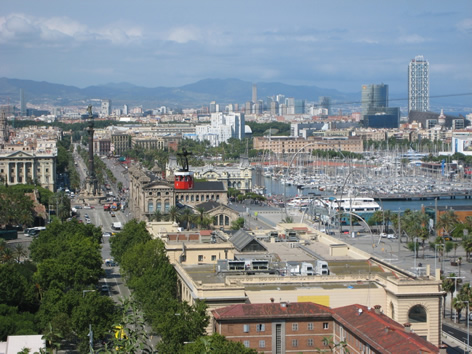
History
The founding of Barcelona is the subject of two different legends. The first attributes the founding of the city to the mythological Hercules 400 years before the building of Rome. The second legend attributes the foundation of the city directly to the historical Carthaginian Hamilcar Barca, father of Hannibal, who named the city Barcino after his family in the 3rd century BC.
About 15 BC, the Romans redrew the town as a castrum (Roman military camp) centered on the "Mons Taber", a little hill near the contemporary city hall (Plaça de Sant Jaume). Under the Romans, it was a colony with the surname of Faventia, or, in full, Colonia Faventia Julia Augusta Pia Barcino or Colonia Julia Augusta Faventia Paterna Barcino. Mela mentions it among the small towns of the district, probably as it was eclipsed by its neighbour Tarraco (modern Tarragona), but it may be gathered from later writers that it gradually grew in wealth and consequence, favoured as it was with a beautiful situation and an excellent harbour. It enjoyed immunity from imperial burdens. The city minted its own coins; some from the era of Galba survive.
Some important Roman ruins are exposed under the Plaça del Rei, entrance by the city museum (Museu d'Història de la Ciutat), and the typically Roman grid-planning is still visible today in the layout of the historical centre, the Barri Gòtic ("Gothic Quarter"). Some remaining fragments of the Roman walls have been incorporated into the cathedral. The cathedral, also known as basilica La Seu, is said to have been founded in 343. The city was conquered by the Visigoths in the early 5th century, becoming for a few years the capital of the whole Hispania. After being conquered by the Arabs in the early 8th century, it was reconquered in 801 by Charlemagne's son Louis, who made Barcelona the seat of Carolingian "Spanish Marches" (Marca Hispanica), a buffer zone ruled by the Count of Barcelona.
The Counts of Barcelona became increasingly independent and expanded their territory to include all of Catalonia. In 1137, Aragon and the County of Barcelona merged bydynastic union by the marriage of Ramon Berenguer IV and Petronilla of Aragon, and their titles were finally borne by only one person when their son Alfonso II of Aragon ascended to the throne in 1162. His territories were later to be known as the Crown of Aragon, which conquered many overseas possessions, ruling the western Mediterranean Sea with outlying territories in Naples and Sicily and as far as Athens in the 13th century. The forging of a dynastic link between the Crowns of Aragon and Castile marked the beginning of Barcelona's decline.
The marriage of Ferdinand II of Aragon and Isabella I of Castile in 1469 united the two royal lines. The centre of political power became Madrid and the colonisation of the Americas reduced the financial importance of Mediterranean trade. Barcelona was always the stronghold of Catalan separatism and was the center of the Catalan Revolt (1640–52) against Philip IV of Spain. The great plague of 1650–1654 halved the city's population. The Napoleonic wars left the province ravaged, but the postwar period saw the start of industrialization.
In the 18th century, a fortress was built at Montjuïc that overlooked the harbor. In 1794, this fortress was used by the French astronomer Pierre François André Méchain for observations relating to a survey stretching to Dunkirk that provided the basis of the meter. The definitive meter bar, manufactured from platinum, was presented to the French legislative assembly on 22 June 1799.
The resistance of Barcelona to Franco's coup d'état was to have lasting effects after the defeat of the Republican government. The autonomous institutions of Catalonia were abolished, and the use of the Catalan language in public life was suppressed. Barcelona remained the second largest city in Spain, at the heart of a region which was relatively industrialized and prosperous, despite the devastation of the civil war. The result was a large-scale immigration from poorer regions of Spain (particularly Andalucia, Murcia and Galicia), which in turn led to rapid urbanization. Barcelona hosted the Olympic Games in 1992, which helped revitalize the city.
Main sites
The Barri Gòtic ("Gothic Quarter" in Catalan) is the centre of the old city of Barcelona. Many of the buildings date from medieval times, some from as far back as the Roman settlement of Barcelona. Catalan modernistaarchitecture (related to the movement known as Art Nouveau in the rest of Europe), developed between 1885 and 1950 and left an important legacy in Barcelona. Several of these buildings are World Heritage Sites. Especially remarkable is the work of architect Antoni Gaudí (http://en.wikipedia.org/wiki/Antoni_Gaud%C3%AD), which can be seen throughout the city. His best-known work is the immense but still unfinished church of the Sagrada Família, which has been under construction since 1882, and is still financed by private donations. As of 2007, completion is planned for 2026.
Barcelona was also home to Mies van der Rohe's Barcelona Pavilion. Designed in 1929 for the International Exposition for Germany, it is an iconic building that came to symbolize modern architecture as the embodiment of van der Rohe's aphorisms "less is more" and "God is in the details." The Barcelona pavilion was intended as a temporary structure, and was torn down in 1930 less than a year after it was constructed. A modern re-creation by Spanish architects now stands in Barcelona, however, constructed in 1986.
Barcelona won the 1999 RIBA Royal Gold Medal for its architecture, the first (and as of 2009, only) time that the winner has been a city, and not an individual architect.
To visit
Sagrada Família, the international symbol of Barcelona
.
Though construction of Sagrada Família had commenced in 1882, Gaudí became involved in 1883, taking over the project and transforming it with his architectural and engineering style—combining Gothic and curvilinear Art Nouveau forms.
Gaudí devoted his last years to the project and at the time of his death in 1926, less than a quarter of the project was complete. Sagrada Família's construction progressed slowly as it relied on private donations and was interrupted by the Spanish Civil War—only to resume intermittent progress in the 1950s. Construction passed the mid-point in 2010 with some of the project's greatest challenges remaining and an anticipated completion date of 2026—the centennial of Gaudí's death. The basílica has a long history of dividing the citizens of Barcelona—over the initial possibility it might compete with Barcelona's cathedral, over Gaudí's design itself, over the possibility that work after Gaudí's death disregarded his design, and the recent possibility that an underground tunnel of Spain's high-speed train could disturb its stability.
Describing Sagrada Familia, art Critic Rainer Zerbst said "it is probably impossible to find a church building anything like it in the entire history of art" and Paul Goldberger called it 'the most extraordinary personal interpretation of Gothic architecture since the Middle Ages'.Palau de la Música Catalana and Hospital de Sant Pau, designed by Lluís Domènech i Montaner, included in the UNESCO Heritage List list in 1997.
The project was financed primarily by the society, but important financial contributions also were made by Barcelona's wealthy industrialists and bourgeoisie. The Palau won the architect an award from the Barcelona City Council in 1909, given to the best building built during the previous year. Between 1982 and 1989, the building underwent extensive restoration, remodeling, and extension under the direction of architects Oscar Tusquets and Carles Díaz (Carandell et al. 2006, 138). In 1997, the Palau de la Música Catalana was declared a UNESCOWorld Heritage Site along with Hospital de Sant Pau. Today, more than half a million people a year attend musical performances in the Palau that range from symphonic and chamber music to jazz and Cançó (Catalan song).
The former Hospital de la Santa Creu i Sant Pau in the neighborhood of El Guinardó, is a complex built between 1901 and 1930, designed by the Catalan modernist architect Lluís Domènech i Montaner. Together with Palau de la Música Catalana, it is a UNESCO World Heritage Site. It was a fully functioning hospital until June 2009, it is currently undergoing restoration for use as a museum and cultural center. As of December 2009 there are still tours of the hospital being given several times a day.Works by Antoni Gaudí, including Park Güell, Palau Güell, Casa Milà (La Pedrera),Casa Vicens, Sagrada Família (Nativity façade and crypt), Casa Batlló, Crypt in Colonia Güell. The first three works were inscribed as a World Heritage Site in 1984. The other four were added as extensions to the site in 2005.
It was a controversial design at the time for the bold forms of the undulating stone facade and wrought iron decoration of the balconies and windows, designed largely by Josep Maria Jujol, who also created some of the plaster ceilings.
Architecturally it is considered an innovative work for its steel structure and curtain walls– the façade is self-supporting. Other innovative elements were the construction of underground car parking and separate lifts and stairs for the owners and their servants.
In 1984, it was declared World Heritage by UNESCO. The building is made open to the public by the Catalunya Caixa Foundation, which manages the various exhibitions and activities and visits to the interior and roof.
The local name for the building is Casa dels ossos (House of Bones), as it has a visceral, skeletal organic quality. It was originally designed for a middle-class family and situated in a prosperous district of Barcelona.
The building looks very remarkable, only identifiable as Modernisme or Art Nouveau in the broadest sense. The ground floor, in particular, is rather astonishing with tracery, irregular oval windows and flowing sculpted stone work.
It seems that the goal of the designer was to avoid straight lines completely. Much of the façade is decorated with a mosaic made of broken ceramic tiles that starts in shades of golden orange moving into greenish blues. The roof is arched and was likened to the back of a dragon or dinosaur. A common theory about the building is that the rounded feature to the left of centre, terminating at the top in a turret and cross, represents the lance of Saint George, which has been plunged into the back of the dragon.Barcelona Cathedral - The Cathedral of the Holy Cross and Saint Eulalia
The cathedral was constructed over the crypt of a former Visigothic chapel, dedicated to Saint James, which was the proprietary church of the Viscounts of Barcelona, one of whom, Mir Geribert, sold the site to Bishop Guislebert in 1058. It is a hall church, vaulted over five aisles, the outer two divided into chapels. The transept is truncated. The east end is a chevet of nine radiating chapels connected by an ambulatory. The high altar is raised, allowing a clear view into the crypt.
The cathedral is dedicated to Eulalia of Barcelona, co-patron saint of Barcelona, a young virgin who, according to Catholic tradition, suffered martyrdom during Roman times in the city. One story says that she was exposed naked in the public square and a miraculous snowfall in mid-spring covered her nudity. The enraged Romans put her into a barrel with knives stuck into it and rolled it down a street (according to tradition, the one now called Baixada de Santa Eulàlia). The body of Saint Eulalia is entombed in the cathedral's crypt.Church of Santa Maria del Mar, Saint Pau del Camp, Palau Reial Major
Sant Pau del Camp is a church and former monastery in Barcelona. While the monastery now stands within the El Raval district in central Barcelona, it once stood outside the city (before 14th century); its rural location gave the church its name.
The Palau Reial Major is a complex of historic buildings in Barcelona, Catalonia, Spain. It was a residence of the counts of Barcelona and, later, of the Kings of Aragon.
The Columbus Monument
The Arc de Triomf
The Arc de Triomf is an archway structure in Barcelona. It was built for the Exposición Universal de Barcelona (1888), as its main access gate by architect Josep Vilaseca i Casanovas.
The arch is built in reddish brickwork in the Neo-Mudéjar style. The front frieze contains the stone sculpture Barcelona rep les nacions (Catalan for "Barcelona welcomes the nations") by Josep Reynés. The opposite frieze contains a stone carving entitled Recompense, a work from Josep Llimona's the earliest period.
The arch is located between Passeig de Lluís Companys and Passeig de Sant Joan, at the end of a wide promenade connecting with the Park of the Ciutadella.Museums
Several museums cover the fields of history and archeology, like the City History Museum, the Museum of the History of Catalonia, the Archeology Museum of Catalonia, the Barcelona Maritime Museum and the private-owned Egyptian Museum. The Erotic museum of Barcelona is among the most peculiar ones, while Cosmo caixa is a science museum that received the European Museum of the Year Award in 2006.Parks
Of Barcelona's parks, Montjuïc is the largest, with 203 ha located on the mountain of the same name. It is followed by Parc de la Ciutadella (which occupies the site of the old military citadel and which houses the Parliament building, the Barcelona Zoo and several museums); 31 ha/76.6 acres including the zoo), the Guinardó Park(19 ha/47.0 acres), Park Güell (designed by Antoni Gaudí; 17.2 ha/42.5 acres), Oreneta Castle Park (also 17.2 ha/42.5 acres), Diagonal Mar Park (13.3 ha/32.9 acres, inaugurated in 2002), Nou Barris Central Park (13.2 ha/32.6 acres), Can Dragó Sports Park and Poblenou Park (both 11.9 ha/29.4 acres), the Labyrinth Park(9.10 ha/22.5 acres), named after the garden maze it contains. There are also several smaller parks, for example, the Parc de les Aigües (2 ha/4.9 acres). A part of the Collserolla Park is also within the city limits. Port Aventura, one of the largest amusement parks in Europe with 3,000,000 visitors per year, is located one hour's drive from Barcelona.Beaches
Entertainment and performing arts
Barcelona has many venues for live music and theatre, including the world-renowned Gran Teatre del Liceu opera house (http://www.liceubarcelona.cat/), the Teatre Nacional de Catalunya (http://www.tnc.cat/), the Teatre Lliure and the Palau de la Música Catalana concert hall (http://www.palaumusica.org/). Barcelona also is home to the Barcelona and Catalonia National Symphonic Orchestra (Orquestra Simfònica de Barcelona i Nacional de Catalunya, usually known as OBC), the largest symphonic orchestra in Catalonia. In 1999, the OBC inaugurated its new venue in the brand-new Auditorium (l'Auditori). It performs around 75 concerts per season and its current director is Eiji Oue.
Yearly two major pop music festivals take place in the city, the Sónar Festival and the Primavera Sound Festival. The city also has a thriving alternative music scene, with groups such as The Pinker Tones receiving international attention.
Sports
FC Barcelona (http://www.fcbarcelona.com/) is a sports club best known worldwide for its football team, one of the largest in the world. It has 62 of national (likewise 41 runners-up) and 15 continental (likewise 10 runners-up) trophies, including four of the UEFA Champions League (likewise 3 runners-up and actually champion) and two of the FIFA Club World Cup (likewise 1 runners-up and actually champion). FC Barcelona also has teams in the Spanish basketball ACB league (Regal FC Barcelona), the handball ASOBAL league (FC Barcelona Handbol), and the roller hockey league (FC Barcelona Hoquei), all of them winners of the highest European competitions. The club's museum is the second most visited in Catalonia.
Barcelona has two UEFA elite stadiums: FC Barcelona's Camp Nou, the largest stadium in Europe with a capacity of 100,000 and the publicly owned Estadi Olímpic Lluís Companys, with a capacity of 55,000; used for the 1992 Olympics. Also, the city has several smaller stadiums such as Mini Estadi, with a capacity of 15,000 andEstadio Narcís Sala, Nou Sardenya with a capacity of 7,000. In the suburbs of Barcelona there is a third UEFA elite stadium - Estadi Cornellà-El Prat, with a capacity of 40,000. Also, except Palau Sant Jordi (St. George's sporting arena), with a capacity of 12,000-24,000 (depending on use), city has two other larger sporting and concert arena: Palau Blaugrana, with a capacity of 7,500 and Palau dels Esports de Barcelona.

Barcelona's Nightlife
A metropolitan city of close to 2 million people, there isn't one area to sample Barcelona's nightlife but rather a whole host of happening neighbourhoods to check out. A natural starting point for newcomers is of course Las Ramblas and - on either side of it - the narrow streets of the medieval Old Town. Barcelona's busiest boulevard by day, Las Ramblas is also heaving by night, especially in the early stages of the evening when the street performers are still playing their trade and the pavements throng with locals and tourists heading out for drinks and dinner. Restaurants at this time are spilling over with customers fuelling themselves on tapas and other treats, whilst the strip also has plenty of bars and clubs, like the Boadas cocktail bar, the Kiosk La Cazalla, Sports Bar Rambles and Boulevard Club to name a few.
Generally speaking however Las Ramblas is merely a crossing point to greener nightlife pastures, and for the more authentic local venues you'll have to negotiate the labyrinthine alleys of the Gothic Quarter. Here you'll find scores of sassy little spots hidden away in dark corners, such as La Divina, Stoke Bar, Sugar and Nevermind, as well as of course a handsome selection of Irish and British pubs, such as Flaherty's, for mingling with (ie. chatting up) fellow tourists. Plaza Real is a great place to orientate yourself in this neck of the woods, with famous clubs like Jamboree, Tarantos and Sidecar perennial faves with the backpacker crowd that congregate here.
For a slightly more sophisticated slice of Barcelona's nightlife, the equally pretty, but slightly less touristy, El Born is also very central and here you'll find all manner of trendily-attired night owls crowding into cafes and bars - especially in the district's heart, the Passeig del Born. Check outMiramelindo and Cactus Bar for two reliable faves, or trawl the backstreets to find hidden hotspots like Coppelia Club or weird and wonderful surprises like Cat Bar.
If you can't identify with Born, then the edgier Raval is the other side of the Ramblas, where street kids play cricket or football and generally run riot as Bohemian imbibers stroke their side whiskers and order another chupito or two. The heart of the district is the Rambla de Raval where hip bars like Zentraus and Ambar are interspersed with kebab joints, whilst a more glam crowd congregate at cocktail bars like the suave Marmalade, where you can order a 'Pornstar Martini' or the lusty 7Sins, where a basement dancefloor creates a pre-club vibe (technically the latter is just out of Raval, by Plac Universitat).
Meanwhile in the area surrounding theMACBA museum, skate fashion rules supreme. Pierced and tattooed kids practice tricks on their boards before later heading down to the Nou de la Rambla, where legendary clubs like Les Enfants (the oldest disco in the city!), Moog (famous for tech/minimal DJs) and Sala Apolo (home of the excellent midweek parties, Nasty Mondays, Crappy Tuesdays and now Thursdays' Cupcake parties!).
A similarly alternative vibe prevails in Gracia, where you’ll find an up-and-coming quarter oozing charisma and aspiring artists – and devoid of tourists. There are many fine bars, or else just hang out on the many squares with a tinnie - illegal but half of Barcelona will be doing the same. And these days Poble Sec is considered a pretty hip barrio, with the likes of Maumau Underground and Rouge Bar attracting a savvy set of drinkers.
For a more upmarket experience put on your best glad rags and hail a cab for the Port Olimpic. Here a string of upmarket lounge bars, such as CDLC, Shoko and Sotavento attract a well-heeled cosmopolitan crowd to sip cocktails on their beach terraces before everyone moves indoors to get down and dirty on the dancefloor. Most of these places close at 3am unfortunately but Opium Mar and Catwalk keep kicking until 6am. For a memorable way to kick off any night at the Port Olimpic we suggest you start by dropping by the Ice Bar, for a dip in their sub-zero chamber. Everything is frozen and even the glasses are made of ice!
If you thought Port Olimpic was posh then get in with the real cool Catalan crowd at upmarket venues like Slow Barcelona and Sutton Club around Diagonal where the girls dress like film stars and the boys look like catalogue cut outs. Slightly more democratic are the likes of City Hall and Otto Zutz, two vast arenas of nocturnal mischief. And if you’re serious about your dance music then you might want to try Discotheque (techno/house), Sala Becool (minimal/electro/tech-house) and of course the legendary open air nightclub in Poble Espanyol – La Terrrazza. Perhaps the best club for a guaranteed good time though is the mammoth Sala Razzmatazz with its five rooms playing everything from serious beeps and blips to cheesy rock and pop. If you're willing to go one step further however and love your dance music take the Row bus or a taxi out toROW14 (just outside Barcelona's centre) for some hardcore hedonism. The main stage boasts a convertible roof and the likes of Laurent Garnier and Tiga drop by!

